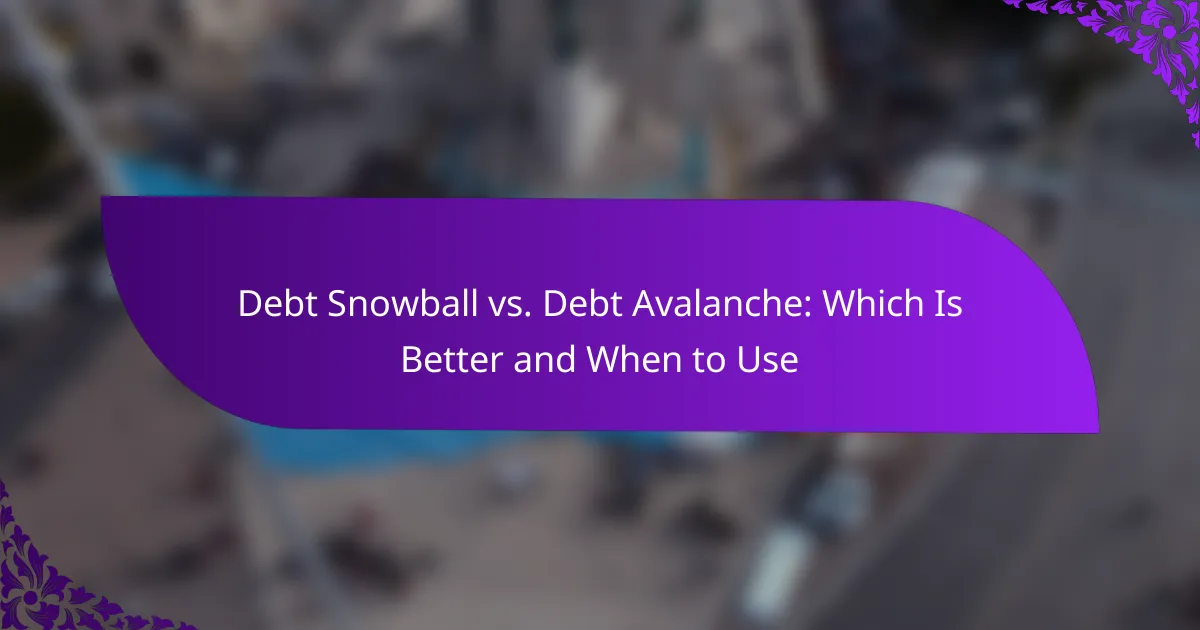When it comes to managing debt, two popular strategies are the Debt Snowball and Debt Avalanche methods. The Debt Snowball focuses on paying off smaller debts first to build momentum, while the Debt Avalanche targets high-interest debts to minimize total interest paid. Understanding the strengths and weaknesses of each approach can help you choose the best strategy for your financial situation and goals.
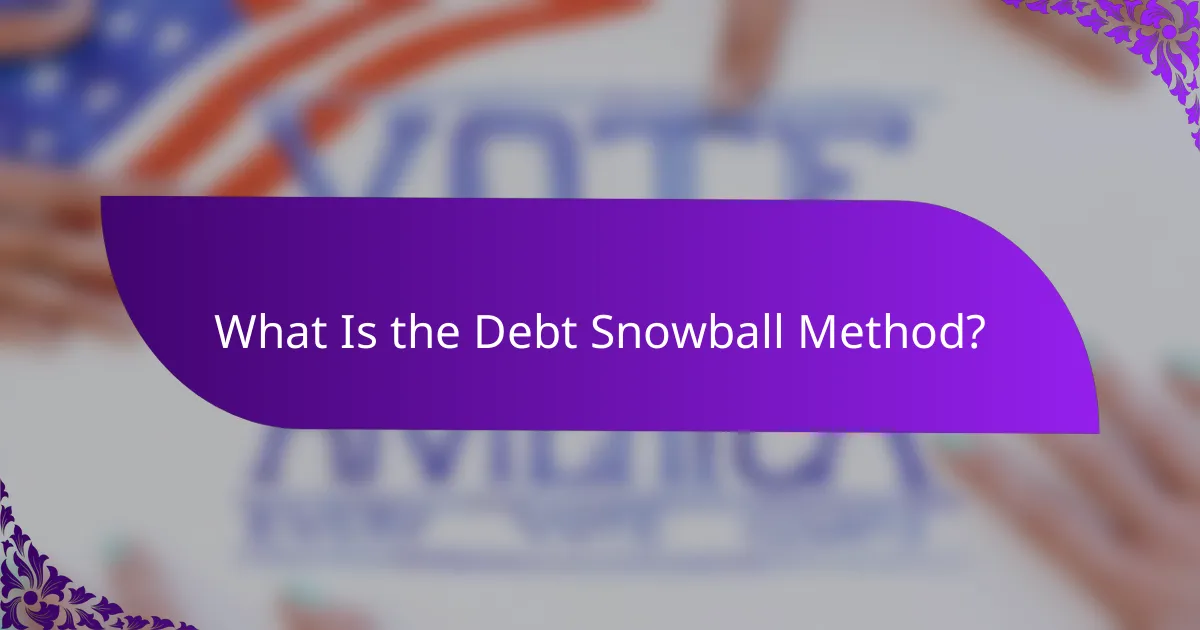
What Is the Debt Snowball Method?
The Debt Snowball Method is a debt repayment strategy that focuses on paying off the smallest debts first, regardless of interest rates. This approach helps build momentum and motivation as you eliminate debts quickly, leading to a sense of accomplishment.
Focus on smallest debts first
The Debt Snowball Method prioritizes your smallest debts, allowing you to pay them off quickly. By listing your debts from smallest to largest, you can concentrate your financial resources on the smallest balance first, making it easier to see progress.
This method encourages you to make minimum payments on larger debts while directing extra funds towards the smallest debt. Once the smallest debt is cleared, you move on to the next smallest, creating a snowball effect as you gain confidence and financial freedom.
Emotional motivation through quick wins
One of the key benefits of the Debt Snowball Method is the emotional boost from quick wins. Paying off smaller debts can provide a sense of achievement, which can be crucial for maintaining motivation throughout the repayment process.
These quick wins can help reinforce positive financial habits and encourage you to stay committed to your overall debt repayment plan. The psychological impact of seeing debts disappear can be a powerful motivator to continue tackling larger debts.
Best for beginners
The Debt Snowball Method is particularly suitable for beginners who may feel overwhelmed by their debt situation. It simplifies the repayment process by focusing on one debt at a time, making it easier to manage and track progress.
This method is ideal for those who may struggle with the more complex calculations involved in other strategies, such as the Debt Avalanche Method, which prioritizes debts based on interest rates. By starting with smaller debts, beginners can build confidence and develop better financial habits.
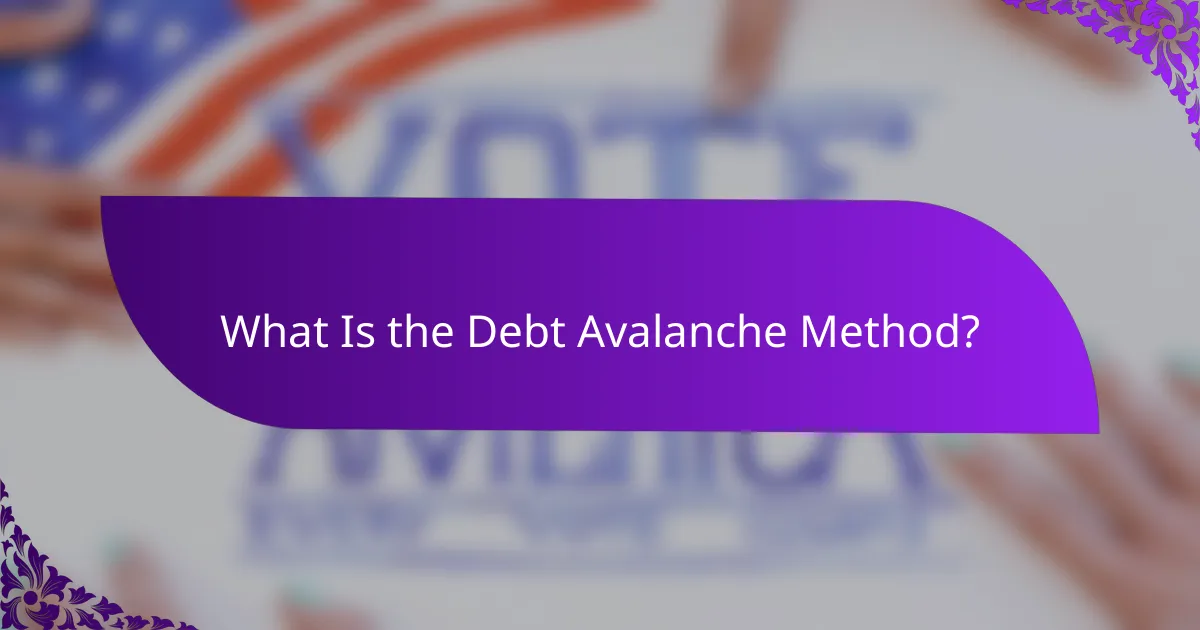
What Is the Debt Avalanche Method?
The Debt Avalanche Method is a strategy for paying off debts by focusing on those with the highest interest rates first. This approach minimizes the total interest paid over time, allowing individuals to become debt-free more efficiently.
Focus on highest interest debts first
The core principle of the Debt Avalanche Method is to prioritize debts with the highest interest rates. By directing extra payments toward these debts, you reduce the overall interest burden more quickly. For example, if you have credit card debt at 20% interest and a student loan at 5%, you would focus on the credit card debt first.
This method requires listing all debts from highest to lowest interest rate. Once the highest-interest debt is paid off, you move to the next one, applying any extra funds to it. This systematic approach helps in reducing the total time spent in debt.
Cost-effective long-term savings
Using the Debt Avalanche Method can lead to significant long-term savings compared to other strategies, such as the Debt Snowball Method. By tackling high-interest debts first, you minimize the amount of interest accrued, which can save hundreds or even thousands of dollars over time.
For instance, if you have multiple debts totaling $10,000 with varying interest rates, focusing on the highest rate can reduce the time to pay off the total debt by several months. This translates to lower overall payments, allowing you to allocate funds towards savings or investments sooner.
Best for disciplined budgeters
The Debt Avalanche Method is particularly suited for individuals who are disciplined with their budgeting and financial planning. It requires a commitment to consistently allocate extra funds toward high-interest debts rather than being swayed by the emotional satisfaction of quickly paying off smaller debts.
To effectively implement this method, create a detailed budget that includes all income and expenses. Set aside a specific amount each month to apply towards your highest-interest debt. Avoid common pitfalls like diverting these funds to other expenses, which can derail your progress.
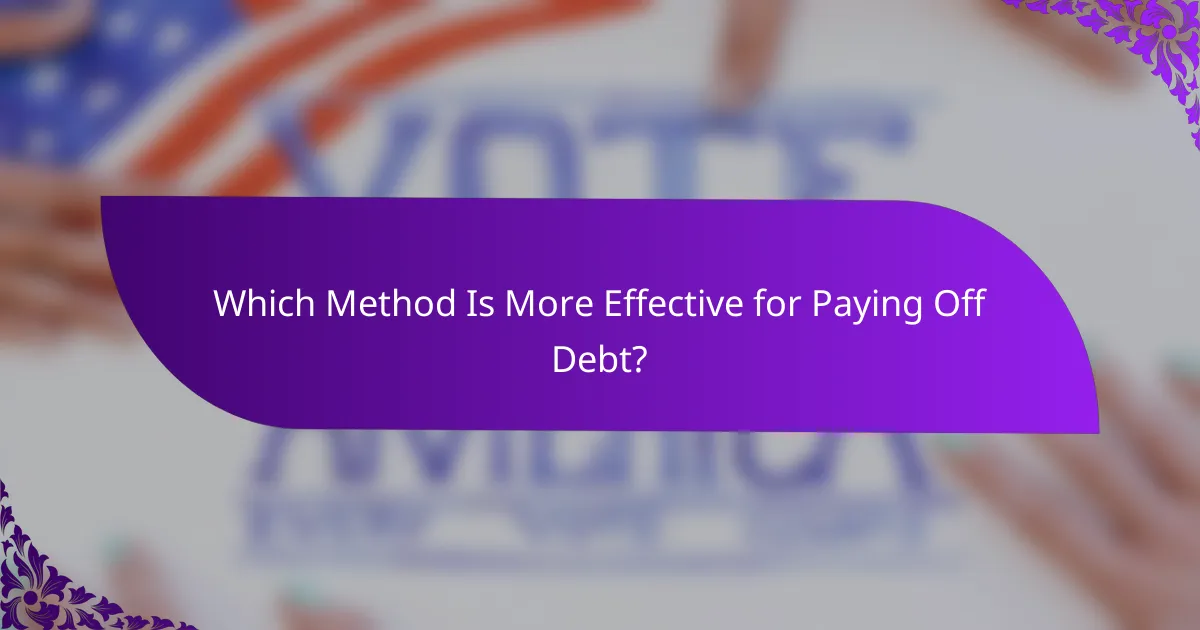
Which Method Is More Effective for Paying Off Debt?
The Debt Avalanche method is generally more effective for paying off debt because it minimizes interest payments over time. By focusing on high-interest debts first, you can save money in the long run, while the Debt Snowball method prioritizes smaller debts for quick wins, which can be motivating but may cost more overall.
Debt Avalanche saves more money
The Debt Avalanche method works by targeting debts with the highest interest rates first. This approach reduces the total interest paid, allowing you to pay off debts faster. For example, if you have a credit card with a 20% interest rate and another with a 10%, you would focus on the 20% card first.
By consistently applying any extra payments to the highest interest debt, you can save hundreds or even thousands of dollars over time. This method is particularly beneficial for those with multiple debts at varying interest rates, as it optimizes your repayment strategy.
Debt Snowball provides psychological benefits
The Debt Snowball method emphasizes paying off smaller debts first, which can provide immediate psychological rewards. By eliminating a debt quickly, you gain a sense of accomplishment that can motivate you to continue tackling larger debts. For instance, if you have three debts of varying amounts, starting with the smallest can boost your confidence.
This method is effective for individuals who struggle with motivation or feel overwhelmed by their debt. While it may result in higher interest payments overall, the emotional benefits of seeing debts disappear can lead to sustained commitment to debt repayment.
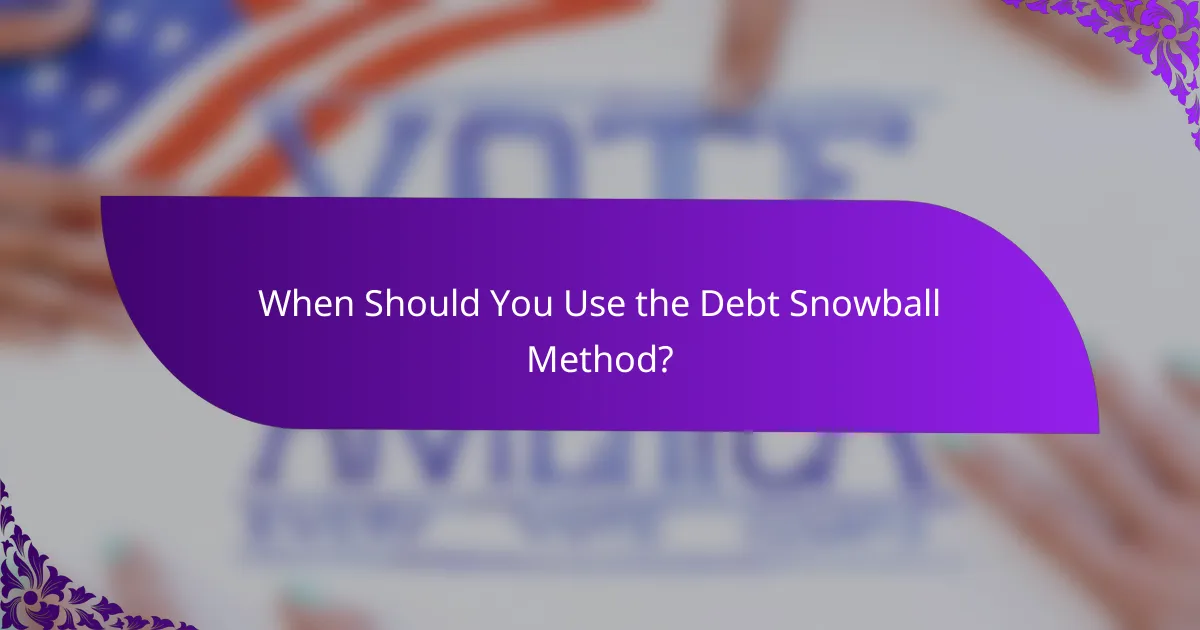
When Should You Use the Debt Snowball Method?
The Debt Snowball Method is most effective when you need quick wins to build momentum in paying off debts. This strategy focuses on paying off the smallest debts first, which can boost motivation and create a sense of accomplishment.
When motivation is needed
If you find it challenging to stay motivated while tackling debt, the Debt Snowball Method can be a powerful tool. By eliminating smaller debts quickly, you experience immediate results that can encourage you to continue your debt repayment journey. Celebrating these small victories can help maintain your commitment to becoming debt-free.
Consider starting with debts that have the lowest balances, regardless of interest rates. For example, if you have three debts of $500, $1,500, and $3,000, focus on paying off the $500 debt first. Once it’s gone, you can apply that payment amount to the next smallest debt, creating a snowball effect.
For smaller total debt amounts
The Debt Snowball Method is particularly suitable for individuals with smaller total debt amounts. When your overall debt is manageable, this method allows you to quickly eliminate debts and reduce the number of creditors you owe. This can simplify your financial situation and reduce stress.
For instance, if your total debt is around $5,000, using the Debt Snowball Method can help you pay it off within a year or two, depending on your monthly payment capacity. This approach is less effective for larger debts, where interest rates may play a more significant role in overall costs.
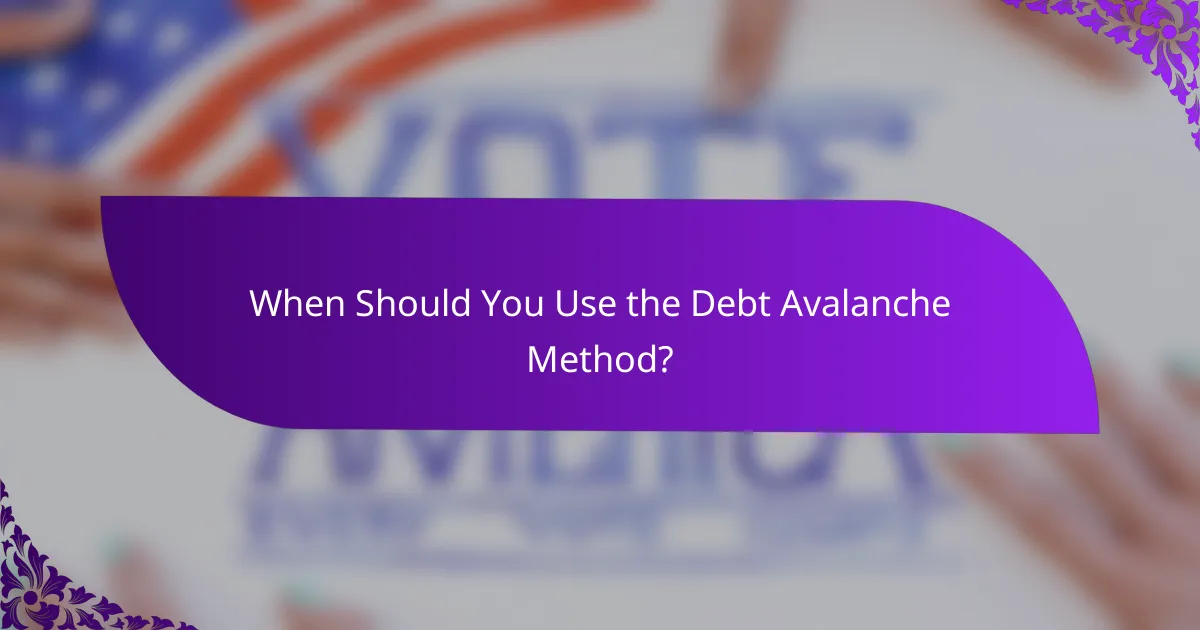
When Should You Use the Debt Avalanche Method?
The Debt Avalanche method is best utilized when you want to minimize the total interest paid on your debts. This approach prioritizes paying off debts with the highest interest rates first, which can lead to significant savings over time.
When interest rates are high
Using the Debt Avalanche method is particularly effective when you have debts with high interest rates. By focusing on these debts first, you can reduce the overall interest you accumulate, which can be substantial if rates are in the double digits.
For example, if you have a credit card debt with an interest rate of 20% and a personal loan at 5%, targeting the credit card first can save you hundreds or even thousands in interest payments over time.
For larger total debt amounts
The Debt Avalanche method is advantageous when dealing with larger total debt amounts. The greater the debt, the more pronounced the effect of high interest rates on your total repayment amount.
For instance, if your total debt is in the tens of thousands, prioritizing high-interest debts can lead to quicker payoffs and less interest paid overall. Consider creating a list of your debts, noting their interest rates, to strategize effectively.

How Do You Choose Between Debt Snowball and Debt Avalanche?
Choosing between the Debt Snowball and Debt Avalanche methods depends on your financial situation and personal preferences. The Debt Snowball focuses on paying off the smallest debts first for quick wins, while the Debt Avalanche prioritizes debts with the highest interest rates to save money over time.
Assess personal financial situation
Start by listing all your debts, including the total amount owed, interest rates, and minimum monthly payments. This overview will help you understand which method may be more effective based on your financial landscape. For example, if you have several high-interest debts, the Debt Avalanche could save you more money in interest payments.
Consider your monthly budget and cash flow. If you have limited funds available for debt repayment, the Debt Snowball might provide the motivation needed to stick with your plan, as it allows for quicker debt elimination. On the other hand, if you can allocate more money towards debt repayment, the Avalanche method may be more beneficial in the long run.
Consider emotional vs. financial priorities
Your emotional response to debt can significantly influence your choice. If you find motivation in celebrating small victories, the Debt Snowball can provide a psychological boost as you eliminate smaller debts. This method can help build momentum and encourage you to stay committed to your overall debt repayment strategy.
However, if you prioritize saving money and reducing interest payments, the Debt Avalanche is likely the better choice. It requires discipline and patience, as it may take longer to pay off the first debt. Weigh your emotional needs against financial goals to determine which method aligns best with your overall approach to debt management.
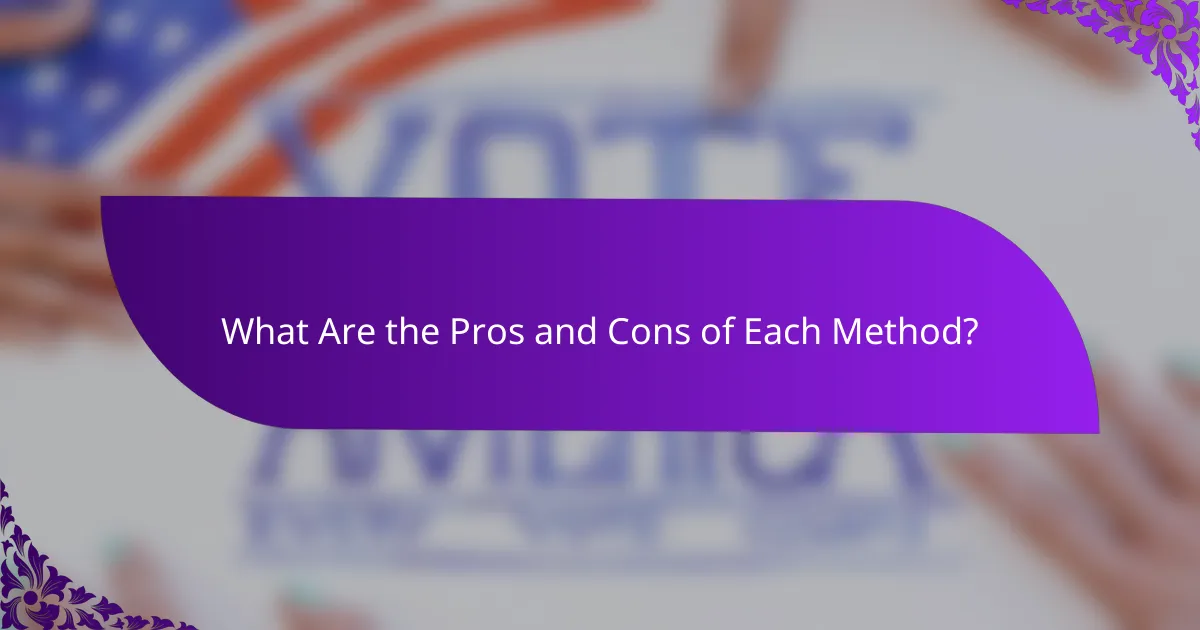
What Are the Pros and Cons of Each Method?
The Debt Snowball and Debt Avalanche methods each have unique advantages and disadvantages that can influence your debt repayment strategy. Choosing the right method depends on your financial situation and psychological preferences.
Debt Snowball pros: quick wins
The Debt Snowball method focuses on paying off the smallest debts first, which can provide quick wins and boost motivation. By eliminating smaller balances, you gain a sense of accomplishment that can encourage you to tackle larger debts.
This method is particularly effective for individuals who struggle with motivation or need immediate results. For example, if you have debts of $500, $1,500, and $3,000, paying off the $500 first can provide a psychological boost that keeps you engaged in your repayment journey.
Debt Avalanche pros: lower total interest
The Debt Avalanche method prioritizes debts with the highest interest rates, which can save you money in the long run. By focusing on high-interest debts first, you reduce the total interest paid over time, making this method financially advantageous.
This approach is ideal for those who are more mathematically inclined and want to minimize costs. For instance, if you have debts with interest rates of 5%, 15%, and 20%, tackling the 20% debt first can significantly decrease the overall interest burden, allowing you to pay off your debts faster.
